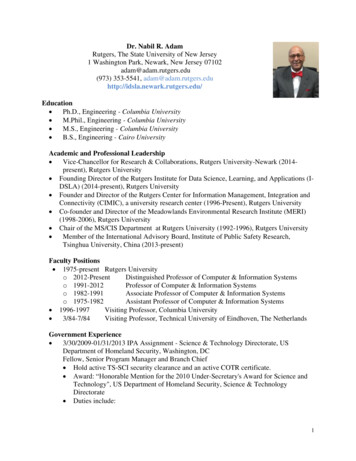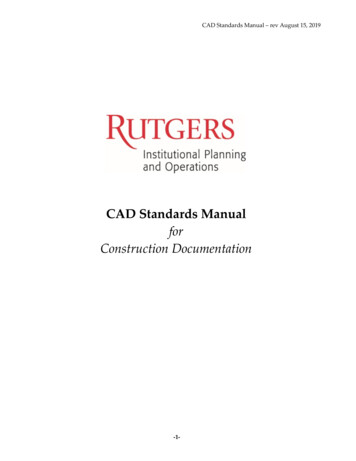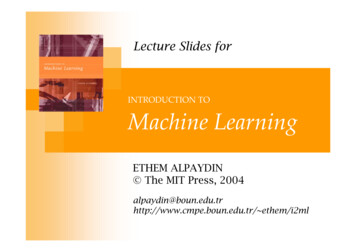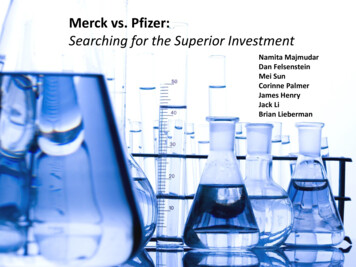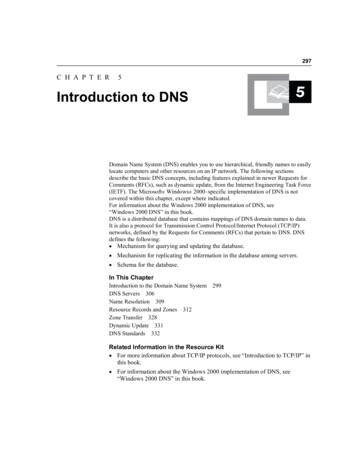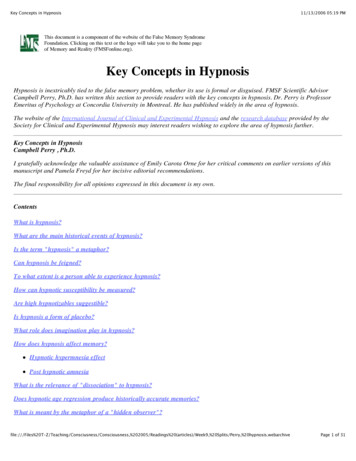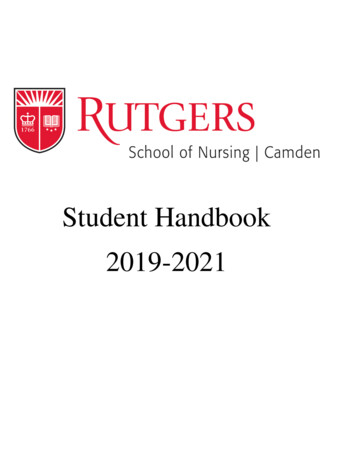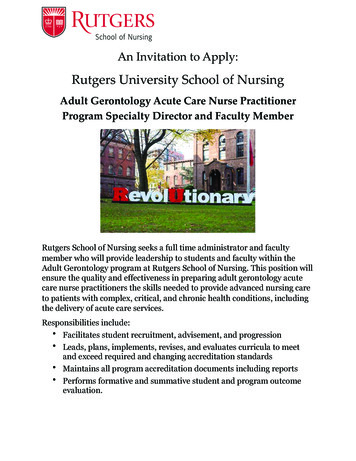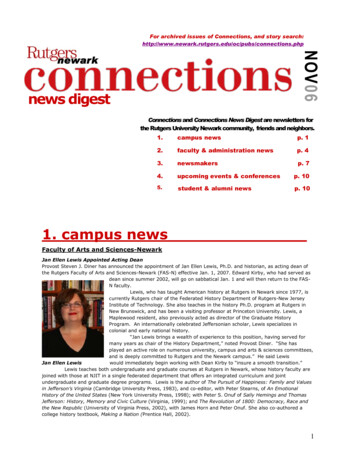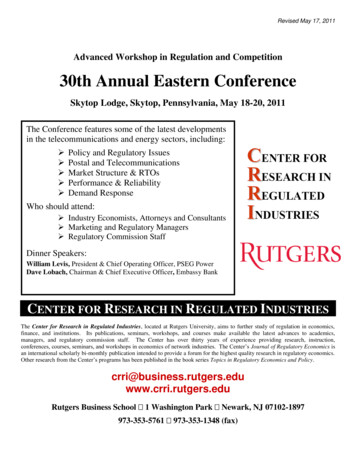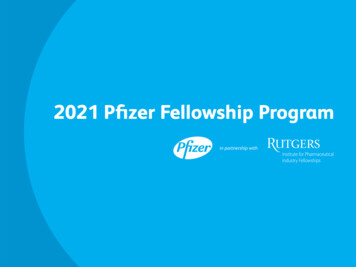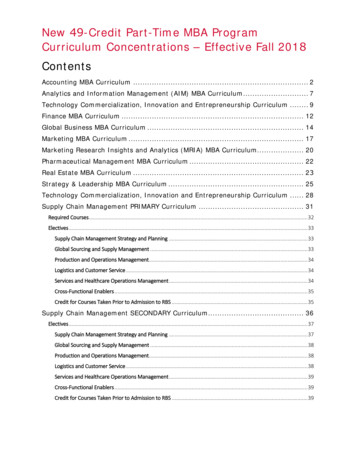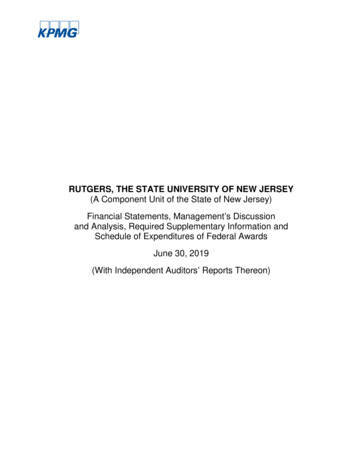
Transcription
RUTGERS, THE STATE UNIVERSITY OF NEW JERSEY(A Component Unit of the State of New Jersey)Financial Statements, Management’s Discussionand Analysis, Required Supplementary Information andSchedule of Expenditures of Federal AwardsJune 30, 2019(With Independent Auditors’ Reports Thereon)
RUTGERS, THE STATE UNIVERSITY OF NEW JERSEY(A Component Unit of the State of New Jersey)Table of ContentsPageIndependent Auditors’ Report3Management’s Discussion and Analysis (Unaudited)6Basic Financial Statements:Statements of Net Position as of June 30, 2019 and 201822Statements of Revenues, Expenses, and Changes in Net Position for the years endedJune 30, 2019 and 201824Statements of Cash Flows for the years ended June 30, 2019 and 201826Notes to Financial Statements28Required Supplementary Information (Unaudited) – Schedules of Employer Contributions,Schedules of Proportionate Share of the Net Pension Liability and Schedules ofProportionate Share of the Total OPEB Liability78Schedule of Expenditures of Federal Awards80Notes to Schedule of Expenditures of Federal Awards119Independent Auditors’ Report on Internal Control Over Financial Reporting and on Complianceand Other Matters Based on an Audit of Financial Statements Performed in AccordanceWith Government Auditing Standards121Independent Auditors’ Report on Compliance for Each Major Federal Program; Report onInternal Control Over Compliance; and Report on Schedule of Expenditures of FederalAwards Required by the Uniform Guidance123Schedule of Findings and Questioned Costs126
-2-
KPMG LLPNew Jersey Headquarters51 John F. Kennedy ParkwayShort Hills, NJ 07078-2702Independent Auditors’ ReportThe Board of GovernorsThe Board of TrusteesRutgers, The State University of New Jersey:Report on the Financial StatementsWe have audited the accompanying financial statements of the business-type activities and the aggregatediscretely presented component units of Rutgers, The State University of New Jersey (the University), acomponent unit of the State of New Jersey, as of and for the years ended June 30, 2019 and 2018, and therelated notes to the financial statements, which collectively comprise the University’s basic financial statementsas listed in the table of contents.Management’s Responsibility for the Financial StatementsManagement is responsible for the preparation and fair presentation of these financial statements inaccordance with U.S. generally accepted accounting principles; this includes the design, implementation, andmaintenance of internal control relevant to the preparation and fair presentation of financial statements that arefree from material misstatement, whether due to fraud or error.Auditors’ ResponsibilityOur responsibility is to express opinions on these financial statements based on our audits. We did not auditthe financial statements of University Physicians Associates of New Jersey, Inc. and Affiliate (UPA), whichrepresent approximately 37%, 20%, 52%, as of June 30, 2019 and 36%, 20%, and 47%, as of June 30, 2018,respectively, of the assets, net position, and revenues of the aggregate discretely presented component units.Those statements were audited by other auditors whose report has been furnished to us, and our opinion,insofar as it relates to the amounts included for UPA, is based solely on the report of the other auditors. Weconducted our audit in accordance with auditing standards generally accepted in the United States of Americaand the standards applicable to financial audits contained in Government Auditing Standards, issued by theComptroller General of the United States. Those standards require that we plan and perform the audit to obtainreasonable assurance about whether the financial statements are free from material misstatement. Thefinancial statements of the discretely presented component units were not audited in accordance withGovernment Auditing Standards.An audit involves performing procedures to obtain audit evidence about the amounts and disclosures in thefinancial statements. The procedures selected depend on the auditors’ judgment, including the assessment ofthe risks of material misstatement of the financial statements, whether due to fraud or error. In making thoserisk assessments, the auditor considers internal control relevant to the entity’s preparation and fair presentationof the financial statements in order to design audit procedures that are appropriate in the circumstances, butnot for the purpose of expressing an opinion on the effectiveness of the entity’s internal control. Accordingly, weexpress no such opinion. An audit also includes evaluating the appropriateness of accounting policies used andthe reasonableness of significant accounting estimates made by management, as well as evaluating the overallpresentation of the financial statements.We believe that the audit evidence we have obtained is sufficient and appropriate to provide a basis for ourunmodified and modified audit opinions.KPMG LLP is a Delaware limited liability partnership and the U.S. memberfirm of the KPMG network of independent member firms affiliated withKPMG International Cooperative (“KPMG International”), a Swiss entity.
Summary of OpinionsBasis for Qualified Opinion on the Aggregate Discretely Presented Component UnitsThe financial statements of University Physicians Associates of New Jersey, Inc. and Affiliate were prepared ona modified basis of cash receipts and disbursements, which is a comprehensive basis of accounting other thanU.S. generally accepted accounting principles. The amount by which this departure would affect the assets, netposition, and revenues of the aggregate discretely presented component units has not been determined.Qualified OpinionIn our opinion, based on our audits and the report of the other auditors, except for the effects of the matterdescribed in the Basis for Qualified Opinion on the Aggregate Discretely Presented Component Unitsparagraph, the financial statements referred to above present fairly, in all material respects, the respectivefinancial position of the aggregate discretely presented component units of the University, as of June 30, 2019and 2018, and the respective changes in financial position thereof for the years then ended in accordance withU.S. generally accepted accounting principles.Unmodified OpinionIn our opinion, the financial statements referred to above present fairly, in all material respects, the financialposition of the business-type activities of the University as of June 30, 2019 and 2018, and the changes infinancial position and cash flows thereof for the years then ended in accordance with U.S. generally acceptedaccounting principles.Other MatterRequired Supplementary InformationU.S. generally accepted accounting principles require that the management’s discussion and analysis and theschedules of employer contributions, schedules of proportionate share of the net pension liability, andschedules of the proportionate share of the total OPEB liability as listed in the table of contents, be presented tosupplement the basic financial statements. Such information, although not a part of the basic financialstatements, is required by the Governmental Accounting Standards Board who considers it to be an essentialpart of financial reporting for placing the basic financial statements in an appropriate operational, economic, orhistorical context. We have applied certain limited procedures to the required supplementary information inaccordance with auditing standards generally accepted in the United States of America, which consisted ofinquiries of management about the methods of preparing the information and comparing the information forconsistency with management’s responses to our inquiries, the basic financial statements, and otherknowledge we obtained during our audit of the basic financial statements. We do not express an opinion orprovide any assurance on the information because the limited procedures do not provide us with sufficientevidence to express an opinion or provide any assurance.4
Other Reporting Required by Government Auditing StandardsIn accordance with Government Auditing Standards, we have also issued our report dated December 18, 2019on our consideration of the University’s internal control over financial reporting and on our tests of itscompliance with certain provisions of laws, regulations, contracts, and grant agreements and other matters.The purpose of that report is solely to describe the scope of our testing of internal control over financialreporting and compliance and the results of that testing, and not to provide an opinion on the effectiveness ofthe University’s internal control over financial reporting or on compliance. That report is an integral part of anaudit performed in accordance with Government Auditing Standards in considering the University’s internalcontrol over financial reporting and compliance.Short Hills, New JerseyDecember 18, 20195
Management’s Discussion and Analysis (unaudited)June 30, 2019The following management’s discussion and analysis (MD&A) provides a comprehensive overview of the financial positionof Rutgers, The State University of New Jersey (the University or Rutgers) at June 30, 2019 and 2018, and its changes infinancial position for the fiscal years then ended, with fiscal year 2017 data presented for comparative purposes.Management has prepared the basic financial statements and related footnote disclosures along with this MD&A inaccordance with generally accepted accounting principles as defined by the Governmental Accounting Standards Board forpublic colleges and universities. This MD&A should be read in conjunction with the audited financial statements andrelated footnotes of the University, which directly follow the MD&A.In fiscal 2019, the financial reporting entity of Rutgers included over 29 degree granting schools and colleges, offering morethan 150 undergraduate majors, more than 400 graduate programs and degrees, with approximately 71,000 studentsenrolled. These schools are located at Rutgers University–New Brunswick, Rutgers University–Newark, and RutgersUniversity–Camden. Rutgers Biomedical and Health Sciences, a division within Rutgers, is an academic health care centerproviding medical education, and conducting research. On July 29, 2016, Rutgers Health Group (RHG), a non-profitcorporation, was incorporated by combining the University’s clinical operations into a single entity. RHG operationscommenced on July 1, 2017 to deliver high quality, cost-effective patient care at clinical locations supportive of theUniversity’s teaching and research missions; to participate in education and research exclusively in support of the charitable,scientific and educational purposes of the University; and to support the University’s education and training of healthcarestudents, post-graduate students and professionals. The University also maintains educational services in many othercommunities throughout the State of New Jersey (the State). The University operates research and institutional facilitieson over 6,000 acres in all 21 counties and 98 municipalities.The University’s financial report includes three basic financial statements: the Statement of Net Position, the Statement ofRevenues, Expenses, and Changes in Net Position, and the Statement of Cash Flows. These statements focus on thefinancial condition of the University, the changes in financial position, and cash flows of the University’s business-typeactivities as a whole rather than the accountability of funds.The financial statements for the Rutgers University Foundation (the Foundation) and University Physicians Associates ofNew Jersey, Inc. and Affiliate (UPA) are presented discretely. The Foundation was formed to aid the University in obtainingprivate funds and other resources to meet the needs and achieve the goals of the University. UPA supports RutgersBiomedical and Health Sciences through administrative assistance to clinical faculty of the New Jersey Medical School.Financial HighlightsThe University’s financial condition at June 30, 2019, improved with an increase in net position of 126.4 million. Totaloperating revenues increased by 146.5 million, or 5.4%, with increases of 5.4% in net student tuition and fees, 10.2% innet patient service revenues, 12.0% in health service contract revenues, 18.7% in other operating revenues and 3.3% inauxiliary revenues offset by decreases of 4.4% in grants and contracts revenue. Operating expenses increased by 69.6million, or 1.7%, primarily due to increases in salaries, wages and fringes, while net non-operating revenues increased by 48.8 million, or 3.5%, primarily due to an increase in contributions.Tuition revenue is a significant source of funding for the University. In fiscal 2019, the enrollment peak was 70,876students compared to 69,198 students in fiscal 2018. Approved increases in tuition and fee rates of about 2.3% were offsetby increases in scholarship allowances.Annual appropriations from the State represent a vital part of the University’s funding. In fiscal 2019, State appropriations,including operating aid and fringe benefits paid on-behalf of Rutgers by the State, increased as a result of additional specialappropriations and higher pension and health care costs to 879.6 million, or 8.1% over fiscal 2018. State appropriations,including OPEB Paid by the State, as well as contributions, investment income, and governmental student aid, are shownas non-operating revenue.Implementation of GASB 68 and GASB 75In June 2012, the GASB issued Statement No. 68, Accounting and Reporting for Pensions (GASB68). This statement addressesaccounting and financial reporting for pensions that are provided to the employees of state and local governmentalemployers through pension plans that are administered through trusts. The university participates in the Public Employees-6-
Retirement System (PERS) and the Police and Firemen’s Retirement System (PFRS) both defined benefit cost-sharingmultiple-employer pension plans. GASB 68 requires that the proportionate share of the net position present value ofprojected benefit payments attributed to past periods of the employee service net of the pension plan’s fiduciary netposition. A cost-sharing employer is also required to recognize its proportionate share of pension expense and reportdeferred outflows and deferred inflows of resources for its proportionate share. The changes in net position liability adjustedfor the deferred inflows and deferred outflows of resources result on pension expense.In June 2015, the GASB issued Statement No. 75, Accounting and Reporting for Postemployment Benefits Other Than Pensions(GASB75). This statement addresses accounting and financial reporting for other postemployment benefits (OPEB) thatare provided to the employees of state and local governmental employers. GASB 75 establishes standards for recognizingand measuring liabilities, deferred outflows of resources, deferred inflows of resources, and expenses related to OPEB inthe basic financial statements, in addition to requiring more extensive disclosures and required supplementary information.For MD&A purposes in order to provide a comparison of 2019 to the prior years, the amounts recorded as a result of theimplementation of GASB 75 have been shown separately along with the results of GASB 68. GASB 75 is applicable forfiscal years 2019 and 2018 in the Statement of Revenues, Expenses and Changes in Net Position.-7-
Statement of Net PositionThe Statement of Net Position presents the financial position of the University at the end of the fiscal year and includes allassets (current and noncurrent), deferred outflows of resources, liabilities (current and noncurrent), deferred inflows ofresources, and net position (the difference between total assets, deferred outflows of resources, total liabilities, and deferredinflows of resources) of the University. Current assets are classified as such if they are available to satisfy current liabilities,which are generally defined as being due within one year of the date of the statement of net position. Net position is oneindicator of the financial condition of the University, while the change in net position is an indicator of whether the overallfinancial condition has improved or worsened during the year. A summarized comparison of the University’s assets,deferred outflows of resources, liabilities, deferred inflows of resources and net position at June 30, 2019, 2018 and 2017is as follows (in thousands):Condensed Statements of Net PositionJune 30, 2019, 2018 and 2017(dollars in thousands)201920182017Assets:Current assets 1,028,490 1,088,315 1,189,075Capital assets, net3,938,2973,772,2423,575,173Other noncurrent ,747,029Noncurrent assets:Total AssetsDeferred Outflows of ResourcesTotal Assets and DeferredOutflows of ResourcesLiabilities:Current 3,988,4254,548,0744,535,1474,689,826Deferred Inflows of Resources380,538281,38317,045Total Liabilities and DeferredInflows of ,8421,750,777Restricted – nonexpendable738,674713,327646,363Restricted – 05)(816,376) 2,192,486 2,066,078 2,040,158Noncurrent liabilitiesTotal LiabilitiesNet Position (Deficit):Net investment in capital assetsUnrestrictedTotal Net Position-8-
For MD&A purposes, the tables below show the impact of GASB 68 to the Statements of Net Position as of June 30, 2019,2018 and 2017.Condensed Statement of Net PositionJune 30, 2019(dollars in thousands)As ReportedAssets:Current assetsNoncurrent assets:Capital assets, netOther noncurrent assets ,276(368,777)101,499Liabilities:Current liabilitiesNoncurrent ,707Total 1,991,541738,674622,096583,116 2,192,486 1,742,941 3,935,427Deferred Outflows of ResourcesDeferred Inflows of ResourcesNet Position (Deficit):Net investment in capital assetsRestricted – nonexpendableRestricted – expendableUnrestrictedTotal Net Position Before GASB 68Adjustment-Total Assets 1,028,490GASB 68Adjustment3,938,2971,684,035Condensed Statement of Net PositionJune 30, 2018(dollars in thousands)As ReportedAssets:Current assetsNoncurrent assets:Capital assets, netOther noncurrent assets ,634(374,409)93,225Liabilities:Current liabilitiesNoncurrent ,052Total 1,905,842713,327511,414615,003 2,066,078 1,679,508 3,745,586Deferred Outflows of ResourcesDeferred Inflows of ResourcesNet Position (Deficit):Net investment in capital assetsRestricted – nonexpendableRestricted – expendableUnrestrictedTotal Net Position3,772,2421,554,417-9- Before GASB 68Adjustment-Total Assets 1,088,315GASB 68Adjustment
Condensed Statement of Net PositionJune 30, 2017(dollars in thousands)As ReportedAssets:Current assetsNoncurrent assets:Capital assets, netOther noncurrent assets ,172(474,654)108,518Liabilities:Current liabilitiesNoncurrent ,448Total 0,777646,363459,394783,992 2,040,158 1,600,368 3,640,526Deferred Outflows of ResourcesDeferred Inflows of ResourcesNet Position (Deficit):Net investment in capital assetsRestricted – nonexpendableRestricted – expendableUnrestrictedTotal Net Position3,575,1731,399,609 Before GASB 68Adjustment-Tota
of Rutgers, The State University of New Jersey (the University or Rutgers) at June 30, 2019 and 2018, and its changes in financial position for the fiscal years then ended, with fiscal year 2017 data presented for comparative purposes. Management has prepared the basic financial statements and
